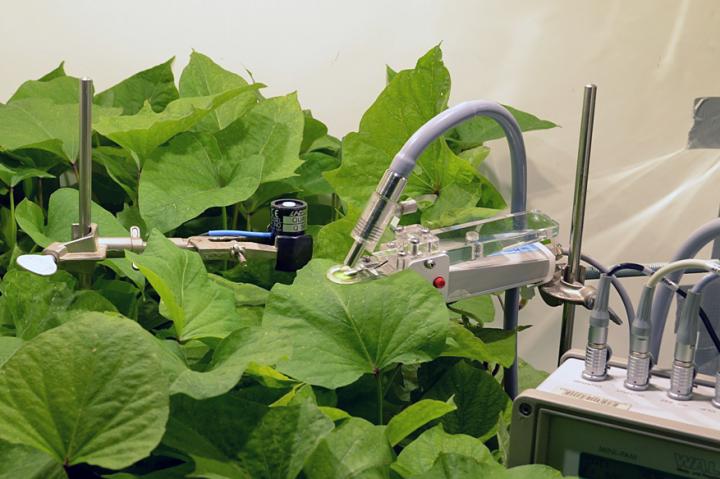Biofeedback system designed to control photosynthetic lighting

A sweetpotato crop is shown in the biofeedback system. Chlorophyll fluorescence measurements are taken on the plant on the right side to determine how efficiently the plant uses the light provided by LEDs. LED light levels are automatically adjusted to maintain specific levels of physiological activity. Photo courtesy Michael T. Martin
Controlled environment agriculture is rapidly becoming an important part of the global food system. For example, there has been much interest in the potential of large-scale, indoor agricultural production – often referred to as vertical farming – as a means to produce high quantities of produce.
These “plant factories” are expensive to operate, however, in part because of the large power requirements of electric lamps that provide the type and amount of light necessary for photosynthesis in plants.
To find new methods of adapting lighting to plants' requirements in controlled environments such as vertical farms, the researchers developed and tested a biofeedback system that allows for the control of light levels based on the physiological performance of the plants.
“Controlling the intensity of light based on plants' ability to use it efficiently may substantially reduce the energy cost of LED lighting, and contribute to making large-scale controlled environment agriculture more profitable,” van Iersel said.
The researchers used lettuce, pothos, and sweetpotato plants in experiments with photosynthetic light provided by a 400-Watt LED. Using chlorophyll fluorescence measurements, a datalogger determined how efficiently the plants used the light they received.
This data was used to calculate the electron transport rate (ETR), which is an indicator of photosynthesis. The datalogger then altered the duty cycle (the proportion of time that the LEDs are energized during each short on/off cycle) of the LEDs to provide more or less light.
The target ETR was altered in a stepwise pattern over a 15-h period. The biofeedback system was capable of automatically adjusting the light levels to assure that the desired ETR was reached. As the target ETR was increased, light levels increased as well. In addition, conversion of light energy into heat (a common way for plants to deal with excess light) was upregulated, while the light use efficiency decreased.
As the target ETR was decreased during the last 7 hours, conversion of light into heat decreased greatly in lettuce and pothos, with only a small increase in light use efficiency. “This suggests that the light use efficiency of lettuce and pothos was limited by a process other than conversion into heat, likely light-induced damage to the photosynthetic machinery in the leaves,” the authors noted.
“The biofeedback system successfully maintained a wide range of ETR values in different species, while it also is capable of distinguishing between conversion of light into heat and damage to the photosynthetic machinery as causes for decreases in light use efficiency,” the authors said. They said the biofeedback system has potential applications in controlled environment agriculture, as well as basic plant physiology studies, where the system can be used to maintain specific levels of physiological activity.
###
The complete study and abstract are available on the ASHS J. Amer. Soc. Hort. Sci. electronic journal web site: http://journal.
Founded in 1903, the American Society for Horticultural Science (ASHS) is the largest organization dedicated to advancing all facets of horticultural research, education, and application. More information at ashs.org
Media Contact
All latest news from the category: Agricultural and Forestry Science
Newest articles

A ‘language’ for ML models to predict nanopore properties
A large number of 2D materials like graphene can have nanopores – small holes formed by missing atoms through which foreign substances can pass. The properties of these nanopores dictate many…

Clinically validated, wearable ultrasound patch
… for continuous blood pressure monitoring. A team of researchers at the University of California San Diego has developed a new and improved wearable ultrasound patch for continuous and noninvasive…

A new puzzle piece for string theory research
Dr. Ksenia Fedosova from the Cluster of Excellence Mathematics Münster, along with an international research team, has proven a conjecture in string theory that physicists had proposed regarding certain equations….



